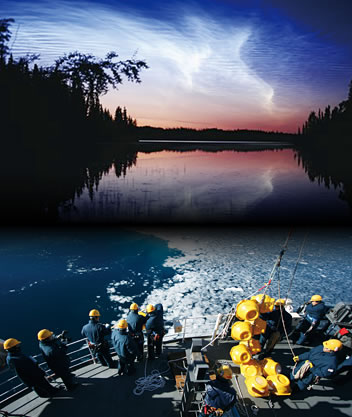
Top: Polar mesospheric clouds
Bottom: Icebreaker Shirase: Installing measuring instruments along the submarine trough.
(Bottom photo: Courtesy of Mr. Keigo Asano)
It might be hard to believe that Antarctica — so isolated, so desolate — plays a vital role in the life of every living organism on Earth. It not only affects global weather and temperatures, but just might hold the key to the future of our planet, or at least our ability to predict what might happen. Today, researchers are looking to the oceans and the skies for clues that will help them understand what lies in store for planet Earth.
What the water tells us
Cold water originating around Antarctica sinks deep in the ocean and circulates around the globe taking about 2,000 years, helping regulate temperatures. It is known as Antarctic Bottom Water (AABW). A similar process in the North Atlantic Ocean creates North Atlantic Deep Water.
“The sea freezes in wintertime at a temperature of about -1.8°C (29°F),” says Dr. Kay I. Ohshima, professor of physical oceanography at the Institute of Low Temperature Science at Hokkaido University. “As the water freezes, it discharges a lot of salt. The saline-dense, cold water sinks deep in the ocean.”
AABW formation originates from coastal polynyas, areas of open water surrounded by sea ice. To gauge where most sea ice production occurs, Dr. Ohshima and his staff used satellites to observe ice formation and measure heat loss caused by wind. “Until recently, it was believed AABW formed in the Ross Sea, an area off Adélie Land and the Weddell Sea,” Ohshima says. “Our satellite survey revealed that the Ross Sea was the most productive, but we found the second most productive place 1,200km (746 mi) east of Syowa Station, off Cape Danley.” The 51st JARE (2009-2010) installed moored measuring instruments to continuously survey this area; the 52nd JARE recovered the instruments a year later and analyzed the data, confirming that AABW is also formed at the Cape Danley polynya.
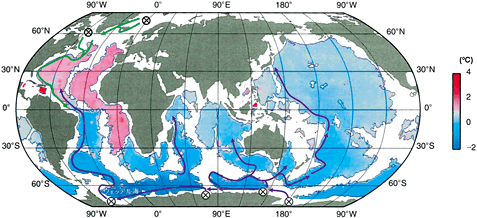
Flows of AABW and temperatures (color shading) at seabeds deeper than 4,000m (2.48 mi). Purple and green arrows indicate flows of AABW and North Atlantic Deep Water (NADW). ![]() indicates origin points of AABW and NADW.
indicates origin points of AABW and NADW.
(Illustration: Courtesy of the Institute of Low Temperature Science, Hokkaido University)
Ohshima’s team employs up to eight measuring instruments to monitor the sinking and flow [of AABW] along the submarine trough. “For the first time, this will reveal how the saline-dense water sinks and forms AABW,” he says.
Ohshima adds that saline-dense water in the Ross Sea and the area off Adélie Land might be decreasing. “This is because global warming is advancing in West Antarctica, causing the ice sheet to melt as fresh water. This does not mean AABW formation will suddenly stop, but we need further research of the interaction between Antarctic ice sheet and ocean.”
Answers high above our heads
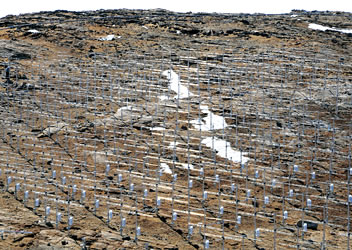
The PANSY radar at Syowa Station. A network is now complete from Antarctica to the tropical belt, and onward to the middle latitudes of the Northern Hemisphere and the North Pole. This is a great leap forward for study of the atmosphere on a global scale.
(Photo: Courtesy of NIPR)
A layer of gases surrounding the Earth, the atmosphere protects life by absorbing ultraviolet solar radiation, warming the surface by retaining heat and regulating temperature. It comprises the troposphere, stratosphere, mesosphere, ionosphere and thermosphere. And Antarctica is the ideal place to study it.
“Antarctica is separated from most of human society,” says Dr. Kaoru Sato, a professor in the Department of Earth and Planetary Science at the University of Tokyo. “From this vantage point, you can clearly detect changes in climate, even small ones.”
JARE is undertaking an ambitious program at Syowa Station to measure changes in the Earth’s atmosphere. Named PANSY, it employs a VHF monostatic pulse Doppler radar system consisting of 1,045 Yagi antennas to observe the entire atmosphere above Antarctica. In March 2011, PANSY successfully conducted its first test, and the whole system will be fully operational sometime in 2013.
Sato says turbulence (yuragi) is PANSY’s key concern. “The PANSY radar detects echoes from yuragi and the strength and direction of winds above the Earth. It also measures electron densities and ion temperatures in the ionosphere.”
PANSY has garnered attention in scientific communities, particularly for its research of polar mesospheric clouds (PMCs) and atmospheric gravity waves.
PMCs are visible in the far northern and southern latitudes after sunset during the summertime. The wispy clouds form at altitudes of about 80km (50 mi), at the edge of space. In recent years, PMCs have occurred more frequently and at lower latitudes.
“PMCs were not reported before the Industrial Revolution,” Sato explains. “Therefore, they are regarded as the result of human activities. They’ve been called ’the canary in a cage’ for Earth’s climate change. We have no information so far about why they started appearing.” PANSY is investigating them in the context of global warming.
Atmospheric gravity waves, characterized by a restoring force of buoyancy, drive global circulation in the middle atmosphere and affect weather systems in the lower atmosphere. Sato says studying them will make predictions of global climate more precise.
“The current model used for predicting global warming suffers from a bias,” she says. “The temperature in the stratosphere during the polar wintertime is lower than predicted, probably because data about atmospheric gravity waves is missing.”
PANSY is slated to last 14 years, and includes research about the 11-year cycle of solar activity. Sato is optimistic about its prospects, as well as the future of the Earth. “The world can change, if there’s a strong will. Humans will find solutions.”
Antarctica is our past, present and future
Antarctica has had a rich geologic, political and scientific history. The continent has not only taught us a lot about our planet and our solar system but also about the human spirit of endurance and exploration. If our thirst for knowledge grows and the spirit of the Antarctic Treaty continues, humans will discover even more about the Earth, space, and ourselves.
-

Nikon Cameras — Tough Enough for the Antarctic
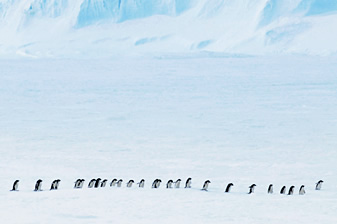
Penguins walk alongside the icebreaker Shirase as it makes its way to Syowa Station.
(Photo: Courtesy of Nobuo Serizawa)When Nobuo Serizawa, a photojournalist for The Sankei Shimbun, traveled to Antarctica with the 52nd JARE, Nikon was his trusted partner. Our cameras and accessories — the D3S, D700 digital SLR cameras and NIKKOR lenses, for example — endured extraordinary conditions from November 2010 to March 2011, helping Serizawa vividly capture JARE’s challenges and activities.
“JARE did not impose limitations on reporters regarding our shooting subjects,” Serizawa says. “A journalist’s obligation is to shoot what he is assigned to. I then determine exactly what I should watch and collect information on, and shoot whatever I feel I should report for the assignment.”
Serizawa also traveled with the 38th JARE more than 10 years ago. His outlook was a bit different for this trip, though. “Before I started out on this expedition, I resolved that I would shoot Antarctica’s beautiful nature in a way that would allow me to say proudly, ’This is the real Antarctica.’”
Serizawa took more than 100,000 photos, including many he considers among his best work. He says he was so captivated by the beauty of the aurora australis that he stood transfixed, forgetting about the passing of time — until his fingers began tingling from the cold. And when he saw penguins, standing or walking, he never let go of his camera. “In the harsh conditions of Antarctica, you have to keep shooting and shooting, because each moment might never happen again. You just keep pressing the button, believing now is the only chance you’ll ever have for an encounter. It’s now or never.“
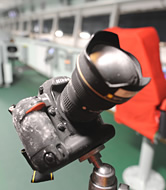
Serizawa shot icebergs and the Southern Cross constellation for six consecutive hours. Though his Nikon D3S froze, it never stopped performing and completed the mission.
(Photo: Courtesy of Nobuo Serizawa)The summer Serizawa spent with the 52nd JARE at Syowa Station was unusually cold. In January 2011, the sun shone less than half the time it normally does, and the number of days with snow and the wind velocity were more than double the usual. Indeed, there were days when people had to be tethered with safety ropes when they ventured outside.
Despite these harsh conditions, Serizawa’s confidence in Nikon products did not waver.
“Nikon products worked; they were dependable in wind chill temperatures that dropped to -30°C (-22°F). The intense coldness did not cause any problems. Controlling dials was easy, even though I was wearing gloves.”
Nikon will continue its legacy of promoting and supporting photography and photographers, undeterred by the severe conditions.
- Nikon Imaging
![[Open in a new window]](/common/img/icon/window.png)
This site provides various information and services about Nikon cameras, including the latest products, press releases, links to local support services and other topics.
- Nikon Imaging
- 1. Antarctica: From Uncertainty to Fact
- 2. Meteorites and Minerals: Tableaux of History
- 3. The Oceans and the Skies

